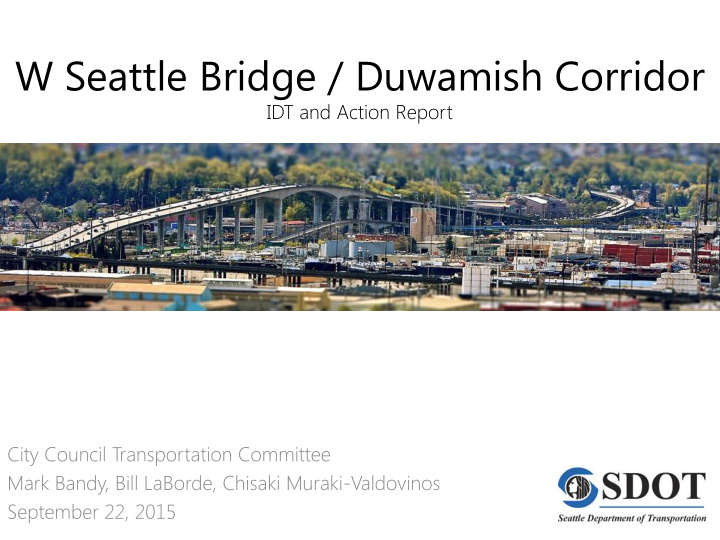



W Seattle Bridge / Duwamish Corridor IDT and Action Report City Council Transportation Committee Mark Bandy, Bill LaBorde, Chisaki Muraki-Valdovinos September 22, 2015
Our mission, vision, and core values Mission : deliver a high-quality Vision : connected people, transportation system for Seattle places, and products Committed to 5 core values to create a city that is: Safe • Interconnected • Affordable • Vibrant • Innovative • For all 2
Briefing overview • Background • Deliverables – Action report including a prioritized project list • Project highlights • Next steps 3
Project background • CM Rasmussen and Mayor charged SDOT with compiling and prioritizing list of projects to address recurring congestion and incident management on Corridor • Number of incidents is low, but impacts are high – 207 collisions between 2012-2015 on upper bridge (107,300 average weekday vehicle crossings) – 30% incidents in AM Peak/30% PM Peak/40% non-peak – Traffic impacts last on average 47-55 minutes per incident • Concurrent SDOT/SPD consultant study examines incident management city-wide 4
Project background (cont’d) • 3 interdepartmental meetings with Council staff, SDOT and SPD Traffic Division to review existing studies, proposals and input previously received from stakeholders • SDOT input from Transportation Ops, Bridges, Transit, Policy & Planning, and Street Use (Sam Schwartz Engineering study) 5
Project background (cont’d) • Drafted action report which includes consolidated issue papers and a prioritized project list • Prioritized project list – Includes recommendations for “early implementation” (0 - 12 months) – Many early implementation recommendations are low/moderate cost or have identified funding – Majority of recommendations are Move Seattle levy- dependent, rely on partnership funding, or require new funding 6
Identified priorities – early initiation (0-12 mo.) $200k Red bus lane on W Seattle Bridge Corridor/intersection ITS improvements: detection, $775k-$1M* blank-out & dynamic message signs, travel-time information TBD Incident management protocols and training Coordination with marine operators for Lower $25k Bridge openings $300-500k Enhanced crossings at 5-Way Alki Trail Connection $1.22k 2k-$1.8 1.8 M TOTAL COST * Priority relies in whole or in part on Move Seattle levy funding 7
Identified priorities – short-term (1-3 years) Metro ($275k for 2-Way Columbia St (and Interim Pathways) interim) $1.1M* 4 th Ave S. transit improvements $43M* Move Seattle RapidRide Plus – Delridge Corridor $1.92M Arterial paving S Spokane St (E of Swing Bridge) $100k ITS and adaptive signal timing at RR crossings $47M M TOTAL COST Priorities with TBD funding to be evaluated based on cost effectiveness 8
Identified priorities – mid-term (4-6 years) $150M § * S Lander St grade separation $600k-1.3M W Marginal Way bike/ped connection Automated camera enforcement of W Seattle bus TBD (requires lane legislative authority) Alaskan Way – all-day BAT lanes (both directions) Waterfront Program $151M+ 1M+ TOTAL COST § Estimate based on 2008 design 9
Identified priorities – long-term (7 years+) ST3 West Seattle to downtown light rail $150-350k* (for Elevated crossing from T-5 overpass to Alki Trail analysis, conceptual design) Add T-18 only lane for WB vehicles on Lower $30M (funding TBD) Spokane St TBD Construction of additional crossings/connections TBD TOTAL COST 10
Project highlights – red bus lanes Intent is to increase awareness of bus-only • restriction and ease SPD enforcement 10 red legends, spaced 400- 500’ across 1 mile • length $200k to implement • 11
Project highlights – operational improvements Incident response protocols • ITS (including dynamic message signs) • T ow-truck response readiness • Re-striping and other potential operational and safety improvements • 12
Project highlights – capital improvements • S. Lander St. Overpass • South End Transit Pathways • 5-way Alki Trail Connection improvements • 4 th Ave S Transit Improvements • Delridge RapidRide • Sound Transit 3 light rail extensions 13
Next steps • Sam Schwartz Engineering incident response recommendations being implemented • Red bus lane on upper West Seattle Bridge • Discussions with USCG and marine stakeholders on improved protocols for lower bridge openings • 9-Year capital implementation plan 14
Questions? Bill.LaBorde@seattle.gov | (206) 684-0102 http://www.seattle.gov/transportation/neighborhood_planning.htm www.seattle.gov/transportation
Recommend
More recommend